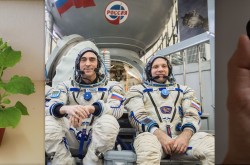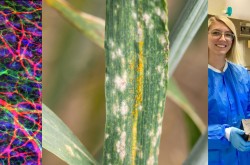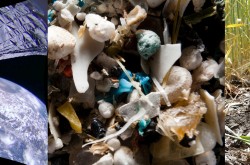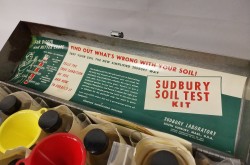3 things you should know — December edition


Meet Renée-Claude Goulet, Jesse Rogerson, and Michelle Campbell Mekarski.
They are Ingenium’s science advisors, providing expert scientific advice on key subjects relating to our three museums — the Canada Agriculture and Food Museum, the Canada Aviation and Space Museum, and the Canada Science and Technology Museum.
In this colourful monthly blog series, Ingenium’s science advisors offer up three quirky nuggets related to their areas of expertise. For the December edition, they tackle the science in your beer, offer tips for viewing the Geminid meteor shower, and bust some myths around alcohol in hot holiday drinks.

Science is everywhere, even in your beer
As holiday celebrations roll around, many will be including an ancient beverage in their merrymaking; we’re talking about beer! Evidence shows humans have been brewing beer for 13,000 years — that’s incredible! For comparison, our species of humans, Homo sapiens, began to evolve about 200,000 years ago, and started domesticating plants and animals 12,000 years ago.
Beer has gone through an evolution of its own over the ages, and today we find ourselves with a beverage concocted from water, yeast, grains (usually barley) and, since about the year 1079, hops.
So what are hops exactly, and what makes them such a ubiquitous part of today’s beer?
Hops, Humulus lupulus, are vigorous vining plants that grow between five and eight metres tall. Members of the order Urticales (from the latin word “urere” — to burn), these plants are covered with hard, pointy hairs that irritate bare skin. This perennial — a plant that grows back every year — is native to temperate regions, and takes about four to five months to produce a crop. It spreads its pollen with the wind, so instead of producing flowers to attract insects, it grows cones containing glands that produce oil. Hop oil is made up of a rich array of compounds; scientists were able to detect over 110 different components from a sample, 47 of which make their way into beer. Research is revealing a myriad of ways hop oil compounds interact with the brewing process to deliver all sorts of results, but of all these interactions, two groups of molecules play the starring roles.
Alpha and beta acids play double-duty. For one, they are responsible for giving beer its bitter taste. They also preserve the flavours and quality of beer longer by protecting it from oxidation, the effect of light, and growth of unwanted micro-organisms.
The second group, called terpenes, are molecules that give beer its aromas and perfumes. Different varieties of hops present different profiles of terpenes. In fact, brewers can now choose from a multitude of varieties to achieve aromas like citrusy, fruity, floral, and herbal. Interestingly, hops and cannabis are in the same plant family: cannabinacae. They share many characteristics and some compounds, like linaool, which gives them both a characteristic spicy-floral aroma.
So next time you sip that super bitter IPA or mellow fruity sour, don’t forget to thank a hop breeder or grower for making all these delicious flavours possible!
By Renée-Claude Goulet

Notice how all the meteors associated with the Geminids are pointing towards a single point. That point is in the constellation Gemini, hence the name of the shower.
Coming soon to a night sky near you: The Geminids meteor shower
One of the best meteor showers of the year — the Geminids — will be peaking Dec. 13-14, 2019. But what is a meteor shower, and what’s the best way to view this year’s Geminids? Let’s answer your questions!
A shooting star is a single meteor, which is caused by tiny pieces of random space rock, probably only the size of a small marble, that burn up when they impact the Earth’s atmosphere. When many meteors occur within minutes of each other over a prolonged period of time, we refer to that as a meteor shower.
The Geminid meteor shower is caused by asteroid 3200 Phaethon, a six kilometre-wide, rocky object that orbits the Sun on a pathway that crosses over Earth’s orbit. As 3200 Phaethon moves along its orbit it is also actively ejecting material, leaving behind a trail of dust and rocks. Annually, around mid-December, Earth plunges through this trail of dust — creating the Geminid meteor shower.
Meteor showers are best seen with the darkest sky possible. Unfortunately, this year the Moon will be just past full, so it will be up all night and very bright. Still, even with the full Moon, the Geminids will be producing 20 to 30 meteors per hour!
If you plan to watch the meteor shower, here are a few things you should keep in mind:
- Find a viewing location away from city lights: parks, rural areas, etc.
- Plan for at least 1-1.5 hours of observing. It takes time for your eyes to adjust to the darkness and you’re going to want to see more than a few meteors!
- The darker it is, the better the observing. This means plan to observe well after sunset (after midnight is best), and well away from city lights.
- Bring friends and family! It’s much more fun (and much safer) to share the experience.
- Dress for the weather! December can be cold, especially at night. Dress in layers, and wear more layers than you think you’ll need. Purchase heat pads to put in your mittens, boots, and under your jacket. Don’t forget your snowpants and toque!
- Bring a thermos of hot chocolate, coffee, or tea…and snacks!
- Be safe: always bring a charged cell phone, a flashlight, and tell someone who’s not going with you where your group is going and for how long
Clear skies!
By Jesse Rogerson

Mull over evaporation rates with a glass of mulled wine this holiday season
Myth busting: hot drinks and alcohol content
When there’s snow on the ground, a chill in the air, and you can’t go outside without putting on five coats…nothing is more appealing than a hot drink topped up with a little “something extra.” From mulled wine to hot toddies and spiked lattes, a hot, boozy beverage is the perfect antidote to the colder months of the year.
But…can you have one and still drive home? What about alcohol that’s drizzled into stews or sauces, added to baked goods, or used to marinate meat? Should you even be giving children a slice of holiday rum cake? Many people believe that most of the alcohol added to a hot drink or stirred into a recipe evaporates (or dissipates), leaving behind only a faint aroma and subtle taste.
Time to myth bust. Simply heating alcohol does not make it evaporate as quickly as your paycheque during the holidays! In a 2007 study, the U.S. Department of Agriculture confirmed the numbers, testing how much alcohol was lost after four types of preparation: no heat, adding to boiling liquid, flaming (setting on fire), and baking.
As one would imagine: the longer you cook, the more alcohol evaporates. BUT it happens much more slowly than you would think. Alcohol molecules hang onto the water molecules in food and drink quite tightly, making the alcohol hard to get rid of. You have to cook food (bake or boil) for about three hours to fully erase all traces of alcohol. An hour of cooking removes about 75 percent of the alcohol, fifteen minutes removes about 60 percent. Setting the liquid on fire (as in a flambé) only removes about 25 percent of the alcohol, while stirring liqueur into a hot beverage only reduces the alcohol content by about 15 percent.
The bottom line: there’s probably more booze in those adult coffees and flambéed deserts than you expect. So remember, if you need to avoid alcohol for any reason, don’t count on a quick bit of applied heat to get rid of it. On the other hand, if you’re worried about that lost 15 percent in your hot boozy beverage, it’s the perfect excuse to add just a little bit extra to your mug.
By Michelle Campbell Mekarski














